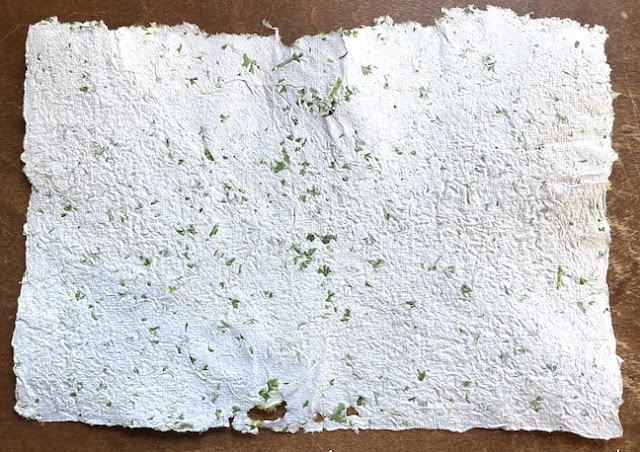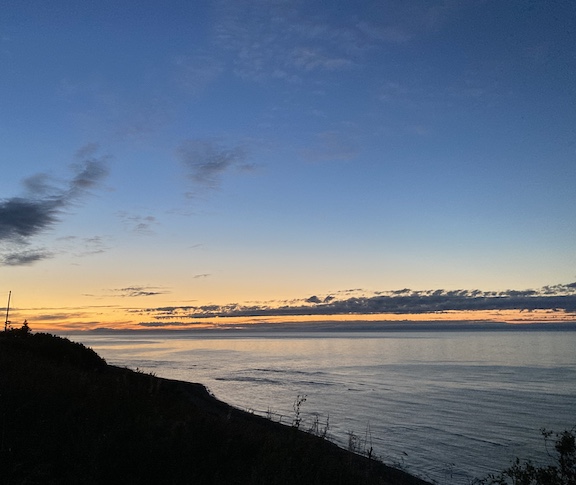When we were at house in the Gaspé in April, the refrigerator stopped working. We bought it new seven years ago. It has seen only eight months' use, since we live most of the time in Montreal. R called the owner of the store, Meubles Vallée in Cap Chat, but he didn't want to hear about it. Nothing but trouble with those refrigerators. He stopped selling them. The people who bought them? Too bad.
We called the 1-800 number that was on the fridge and were told that a work order could be requested, but in our sector the repair person travelled around the coast only once a month. We couldn't be there for the upcoming date because I had a medical procedure booked in Montreal. Fridge? Heart? There are priorities.
The situation wasn't dire since the temperature was cool enough outside that we could keep the cooler with perishables in the shed. And then, voilà! The fridge started working again.
Nevertheless, on our next trip R brought tools to undo a panel as advised by the woman at 1-800 and vacuumed the fridge innards. He took off the front grill and vacuumed there too. Everything seemed fine. In any case, the fridge was working.
When we returned in August, the fridge stopped again. R vacuumed the innards but nothing happened. We kept pressing the button for temperature control. There is no reset button. We unplugged, waited, and plugged it in again. Repeat. Repeat.
Are you wondering what make of refrigerator this is so you don't buy one? AMANA.
R called 1-800 again and was told there were no available appointments with the Once-a-Month repair person until October--except for Sunday of the Labour Day weekend! Did we believe that someone who only does a repair trip around the coast once a month was going to come on the Sunday of a long weekend? No.
We had put our perishables in the cooler with freezer packs and were okay for a day. We wanted to buy ice, but with so many vacationers having picnics on the beaches in the Gaspé, the ice freezers were empty. R was finally able to get ice by driving to a store in a village that didn't have a beach.
We asked the neighbours if they would put our freezer packs in their freezer. R asked another neighbour if he knew someone local who repaired fridges. He gave R a name but didn't have a phone number. He said to drive two villages over and take not the street at the first river but the street at the second river. He didn't know the house number and there was no sign, but we should look for the truck. We found the right street and drove along it for a couple of kilometres. We saw no truck.
R stopped to ask a man unpacking groceries if he knew where Mr Repairperson lived. He said to go past the bend and look for a white house. Do you know how many white houses there are on the coast? Luckily an extra clue: the house we were looking for had a new garage, also white. Past the bend were two white houses with a new white garage between them. R rang doorbells. No answer.
Back to the village where we stopped at the small administrative building. R asked if they could confirm an address and maybe give him a phone number. They could, except that the name we'd been given was for the Electrician! Refrigeration was another name. But yes, at that address. White house with a white garage. R called the number and got an answering machine. He left a message.
 |
| From the angle, you can see that I was waiting for frîtes maison, though I was equally tempted by the crème molle window |
Later that afternoon, R was napping on the beach when he heard voices in the trees behind him. The neighbour who had our freezer packs was doing something among the trees. When he stepped onto the beach and saw R, he asked if our fridge was still broken. Yes. The man who was with him said that he knew how to repair refrigerators and would be happy to come the next morning.
When R returned to the house, the fridge was working again. Then his phone rang. It was Mr Once-a-Month who said he could come in two days. R said the fridge was now working. Mr Once-a-Month said that from the sounds of it, the computer was defective and needed to be replaced. (The computer? What happened to motors that simply worked or didn't and could be fixed.) A fridge computer cost approx $300. We would also have to pay for the visit as well as his time. He said he would call again the next evening to see if the fridge was still working. He didn't seem to think it would be.
Where was I during all this? Clambering on the rocks and staring into tidal pools.
When I returned, R told me about the developments. I was dubious that the fridge would keep working and waited a couple of hours before unpacking the perishables (the damn perishables) from the cooler. The problem with bags of ice is that they leak water. The cardboard carton of eggs was sodden. To get ready for the next possible breakdown we recouped the freezer packs, now frozen solid, from the neighbour.


The next day at 8:15 a.m. the man from the beach who knew how to repair refrigerators arrived with a plastic bag of tools, but since the fridge was working, he didn't look at it. We chatted for a while. He told us that the fellow who had bought the old church was going to turn it into a microbrasserie. He kept eyeing the top of the fridge. He was very tall and I began to wonder if he was appalled by the dust. I'm short and I forget about high-up surfaces. Finally he said that he was trying to figure out whether the fridge was level. R got his tool with the bubble and checked. The front was a millimetre higher than the back. That wouldn't be the cause for the breakdowns but he adjusted it.
Later in the afternoon, when we were out walking, Mr Once-a-Month called. R verified that even though the fridge was still under warranty, we would have to pay for the visit plus time plus parts. Since the fridge was working, we decided to forgo the appointment. If we needed him at some point in the future, we would call and hope it coincided with one of his monthly visits. Or that the weather would be cool enough that we could keep perishables outdoors. Old-style refrigeration.
 |
| dog-chewed veneer dresser revived with blue paint |
We got home and the fridge was no longer working correctly. The motor was running, but there was no refrigeration and the temperature buttons didn't respond. We called Mr Once-a-Month, but someone else answered the phone, the work order had been cancelled, and our fridge problem was back at the bottom of the list. By then, the fridge stopped working completely. I packed the few remaining perishables in the cooler with the freezer packs that we'd recouped from the neighbour. Fortunately we were returning to Montreal the next morning.
That night, in the middle of the night, the refrigerator began working again, but for how long?
We never did hear from the refrigerator repair person who lives two villages over, not at the first river but the second. We will go look for his truck when we return. Our new tall friend, like us, doesn't live in the Gaspé year-round and probably won't be there to help when we next go.
I don't know that I believe that Mr. Once-a-Month truly exists.
ps (one month later) He does exist. We now have a date for when he will come.
 |
| life lesson about tides: at high tide there's half a metre of water around this rock |
 |
| this, our last evening on the coast (for now); we love the less dramatic sunsets too |



















































